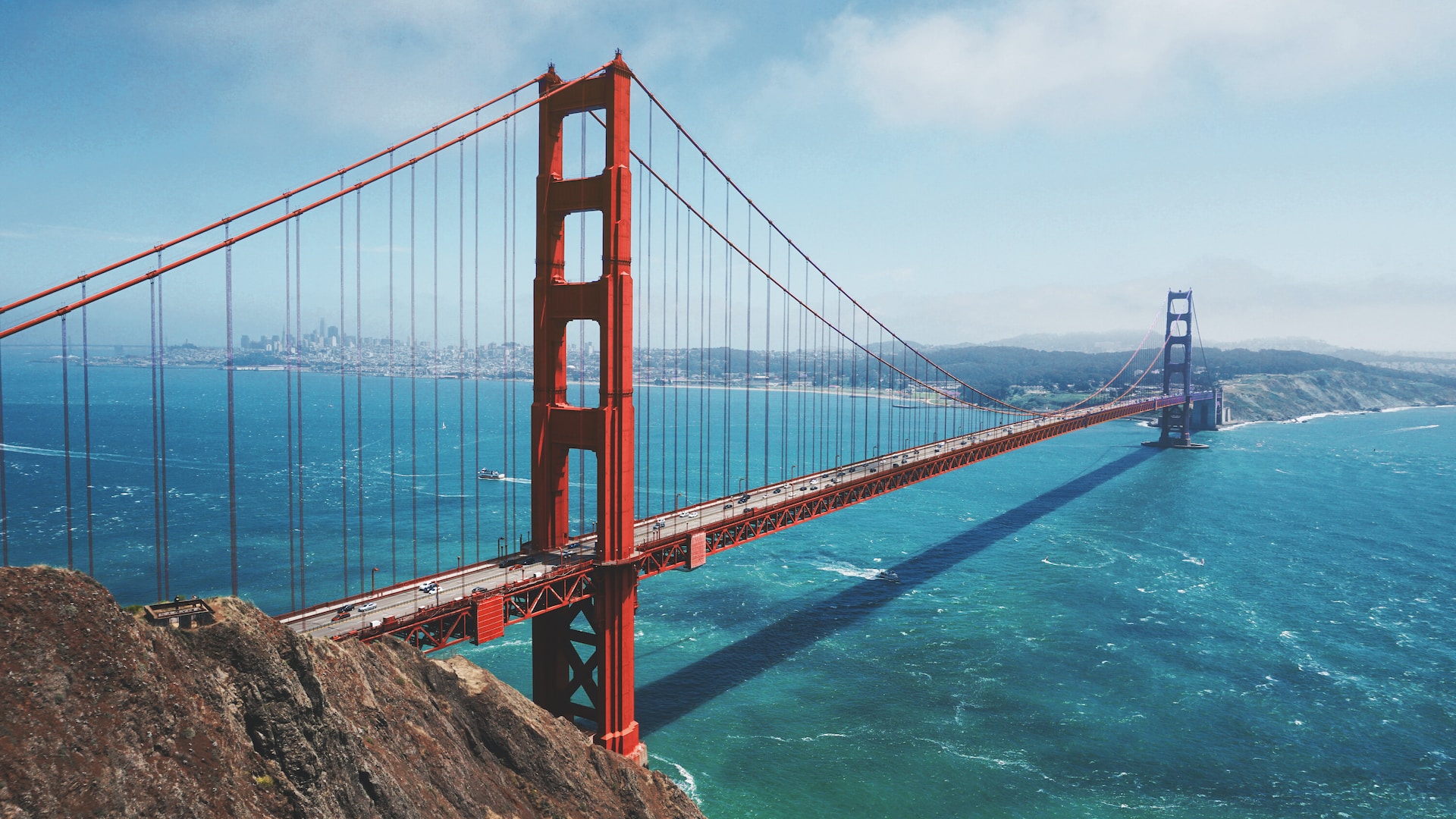Author | Lucía Burbano
The Golden Gate Bridge is probably the most photographed bridge in the world. In fact, in 2018, it was the ninth most photographed attraction in the United States on Instagram. An icon of San Francisco and a symbol of early 20th century engineering, its history is full of milestones.
Unsurprisingly, in 1994, the Golden Gate Bridge was named one of the seven wonders of engineering of the Modern World by the American Society of Civil Engineers.
History of the Golden Gate Bridge
The project to build a bridge that would join the 2.7 km that separate San Francisco from Marin County came about when, years after the end of World War I, road traffic increased to such a degree that the ferries that transported these vehicles on their journey across the Bay could not cope with the high number of vehicles.
After numerous attempts, it was in 1928 when permission was given to construct this hanging bridge, approximately 1,280 meters long, suspended between two towers standing 227 meters tall and with a capacity for six lanes and sufficient space (67 meters) for boats to circulate below.
Construction work on the bridge began in 1933. The chief engineer of the Golden Gate Bridge was Joseph Strauss, who introduced a series of innovations described below.
An engineering wonder
In 1921, Strauss presented his design for the bridge that would join the Golden Gate strait: a hybrid bridge with a suspension span supported at each end by cantilever trusses.
In 1929, the consulting engineers Leon S. Moisseiff and O.H. Ammann convinced Strauss to accept the current design. Moisseiff, specifically, had experience building suspended bridges including the Manhattan Bridge in New York.
Strauss commissioned the engineer Charles A. Ellis to work in collaboration with Moisseiff to perform the calculations needed to complete the design, which were verified with tests on a steel tower model of 1:56 scale (56 times smaller than one of the actual towers). The tests confirmed that the calculation of the towers – essential elements for their viability since they support the two main cables – were correct.

The main problem with the idea of building a suspended bridge in this area was that the structure was exposed to high-speed winds from the Pacific. As a strategy to combat this, the bridge was designed to withstand speeds of 100 miles per hour (160 km/h).
Extremely accurate calculations and extraordinary solutions were required to tackle this challenge, since all materials deform when loads are applied. The weight of the bridge deck and vehicles is transferred up through the suspender rods to the main suspension cable, which in turn transfers the force to the two bridge towers and the anchor blocks.
The main suspension cable, which is dished, is made up of more than 25,000 small diameter steel cables rolled up to create an enormous, plaited steel cable. The cable produces compressive forces in the tower that try to compress it without the structure buckling.
The Golden Gate Bridge was inaugurated on May 27, 1937. Around 200,000 people walked across it and the next day road traffic did the same. In total, 25,000 vehicles crossed the 2.7 km that unite the bay. Such was the expectation surrounding the inauguration, that celebrations lasted nine days.
Why is it called the Golden Gate Bridge?
There is actually nothing romantic about the name; it is in fact the name given to the strait that the bridge passes over: Golden Gate Strait, the entrance to the San Francisco Bay from the Pacific Ocean.
The story behind the name of the strait is somewhat more romantic and exotic. In 1846, Captain John C. Fremont, a topography engineer in the US Army christened it Chrysopylae (Golden Gate) because it reminded him of a port in Istanbul called Chrysoceras or Golden Horn, located in the Bosphorus Strait.
There is also an explanation for the orange color of the bridge. Fog is a common weather phenomenon in the San Francisco Bay Area and the Pacific Ocean causes the steel used to build the bridge to rust.
Although the US Marine proposed painting the bridge with black and yellow sections to increase visibility, the color known as "international orange" was used, a unique blend designed for the bridge, 69% magenta, 100% yellow and 6% black.
5 facts about the Golden Gate Bridge

● Since its construction, it has survived numerous earthquakes.
The most powerful of these was the major earthquake in San Francisco in 1989, measuring 6.9 on the Richter scale. In June 1935, while construction was underway, a strong earthquake shook the bridge and the men working on the south tower reported that the pillar was swinging 4 meters from one side to another. Despite all of this, it has only been closed three times due to strong winds.
● More than 2 billion cars have crossed the Golden Gate Bridge.
According to the Golden Gate Bridge Highway and Transportation District, the bridge carries around 112,000 cars each day. In May 1937, the toll system was inaugurated, with a price of 50 cents per trip. Today, crossing the world’s most famous bridge costs 9 dollars.
● When it was inaugurated in 1937, the Golden Gate Bridge was the longest and the tallest bridge in the world.
This record was exceeded by the Verrazano Bridge in New York.
● A great supporting act.
Although it has never won an Oscar, the Golden Gate Bridge has appeared in classic and modern movies including Alfred Hitchcock’s Vertigo (1958), Superman (1978), A View to a Kill (1985), with James Bond or Minions: The Rise of Gru (2022).
● Safety was one of the main priorities of the project.
The construction of the Golden Gate Bridge was pioneering in terms of ensuring the safety of its workers. Still unusual, helmets were mandatory and an innovative safety net was installed under the bridge, which saved 19 lives.
Photographs | Maarten van den Heuvel, Golden Gate Bridge Highway & Transportation District






















































